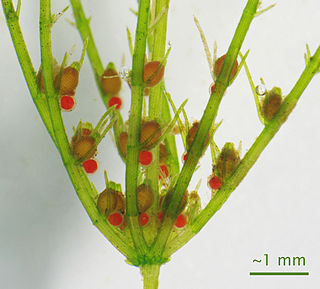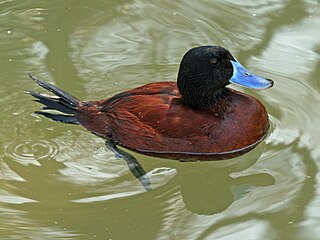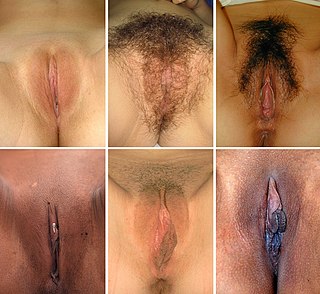Related Research Articles

The clitoris is a female sex organ present in mammals, ostriches and a limited number of other animals. In humans, the visible portion – the glans – is at the front junction of the labia minora, above the opening of the urethra. Unlike the penis, the male homologue (equivalent) to the clitoris, it usually does not contain the distal portion of the urethra and is therefore not used for urination. In most species, the clitoris lacks any reproductive function. While few animals urinate through the clitoris or use it reproductively, the spotted hyena, which has an especially large clitoris, urinates, mates, and gives birth via the organ. Some other mammals, such as lemurs and spider monkeys, also have a large clitoris.

The labia minora, also known as the inner labia, inner lips, vaginal lips or nymphae are two flaps of skin that are part of the human vulva, extending outwards from the vaginal and urethral openings to encompass the vestibule. The labia minora are situated between the labia majora and together form the labia. They vary widely in size, color and shape from individual to individual.

A sex organ, also known as a reproductive organ, is a part of an organism that is involved in sexual reproduction. Sex organs constitute the primary sex characteristics of an organism. Sex organs are responsible for producing and transporting gametes, as well as facilitating fertilization and supporting the development and birth of offspring. Sex organs are found in many species of animals and plants, with their features varying depending on the species.

Genital modifications are forms of body modifications applied to the human sexual organs, such as piercings, circumcision, or labiaplasty.

The G-spot, also called the Gräfenberg spot, is characterized as an erogenous area of the vagina that, when stimulated, may lead to strong sexual arousal, powerful orgasms and potential female ejaculation. It is typically reported to be located 5–8 cm (2–3 in) up the front (anterior) vaginal wall between the vaginal opening and the urethra and is a sensitive area that may be part of the female prostate.

Tribadism or tribbing, commonly known by its scissoring position, is a lesbian sexual practice in which a woman rubs her vulva against her partner's body for sexual stimulation, especially for stimulation of the clitoris. This may involve vulva-to-vulva contact or rubbing the vulva against the partner's thigh, stomach, buttocks, arm, or other body parts. A variety of sex positions are practiced, including the missionary position.

The baculum is a bone in the penis of many placental mammals. It is absent from the human penis, but present in the penises of some primates, such as the gorilla and the chimpanzee. The baculum arises from primordial cells in soft tissues of the penis, and its formation is largely influenced by androgens. The bone lies above the urethra, and it aids sexual reproduction by maintaining stiffness during sexual penetration. The homologue to the baculum in female mammals is the baubellum, a bone in the clitoris.

A hemipenis is one of a pair of intromittent organs of male squamates. Hemipenes are usually held inverted within the body, and are everted for reproduction via erectile tissue, much like that in the human penis. They come in a variety of shapes, depending on species, with ornamentation, such as spines or hooks. The female homologue is the hemiclitoris.

The lake duck is a small, South American stiff-tailed duck. It is also called the Argentine blue-bill, Argentine blue-billed duck, Argentine lake duck, or Argentine ruddy duck.
A pseudo-penis is any structure found on an animal that, while superficially appearing to be a penis, is derived from a different developmental path.

A penis is the primary sexual organ that male animals use to inseminate females during copulation. Such organs occur in many animals, both vertebrate and invertebrate, but males do not bear a penis in every animal species. Furthermore, penises are not necessarily homologous.
The reproductive system of an organism, also known as the genital system, is the biological system made up of all the anatomical organs involved in sexual reproduction. Many non-living substances such as fluids, hormones, and pheromones are also important accessories to the reproductive system. Unlike most organ systems, the sexes of differentiated species often have significant differences. These differences allow for a combination of genetic material between two individuals, which allows for the possibility of greater genetic fitness of the offspring.

The vulva consists of the external female sex organs. The vulva includes the mons pubis, labia majora, labia minora, clitoris, vestibular bulbs, vulval vestibule, urinary meatus, the vaginal opening, hymen, and Bartholin's and Skene's vestibular glands. The urinary meatus is also included as it opens into the vulval vestibule. Other features of the vulva include the pudendal cleft, sebaceous glands, the urogenital triangle, and pubic hair. The vulva includes the entrance to the vagina, which leads to the uterus, and provides a double layer of protection for this by the folds of the outer and inner labia. Pelvic floor muscles support the structures of the vulva. Other muscles of the urogenital triangle also give support.
An intromittent organ is any external organ of a male organism that is specialized to deliver sperm during copulation. Intromittent organs are found most often in terrestrial species, as most non-mammalian aquatic species fertilize their eggs externally, although there are exceptions. For many species in the animal kingdom, the male intromittent organ is a hallmark characteristic of internal fertilization.

Many mammalian species have developed keratinized penile spines along the glans and/or shaft, which may be involved in sexual selection. These spines have been described as being simple, single-pointed structures (macaques) or complex with two or three points per spine (strepsirrhines). Penile spine morphology may be related to mating system.
Genital regeneration encompasses various forms of treatment for genital anomalies. The goal of these treatments is to restore form and function to male and female genitalia by taking advantage of innate responses in the body. In order to do this, doctors have experimented with stem cells and extracellular matrix to provide a framework for regenerating missing structures. More research is needed to successfully move the science from laboratory trials to routine procedures.

Neotrogla is a genus of barklice noted for its reversed sex roles and organs, traits shared by all species of the genus.
Female genital mutilation in Sierra Leone is the common practice of removing all or part of the female's genitalia for cultural and religious initiation purposes, or as a custom to prepare them for marriage. Sierra Leone is one of 28 countries in Africa where female genital mutilation (FGM) is known to be practiced and one of few that has not banned it. It is widespread in part due to it being an initiation rite into the "Bondo," though initiation rite-related FGM was criminalised in 2019. The type most commonly practised in Sierra Leone is Type IIb, removal of part or all of the clitoris and the labia minora. As of 2013, it had a prevalence of 89.6%.

The vagina and vulva have been depicted from prehistory onwards. Visual art forms representing the female genitals encompass two-dimensional and three-dimensional. As long ago as 35,000 years ago, people sculpted Venus figurines that exaggerated the abdomen, hips, breasts, thighs, or vulva. There have long been folklore traditions, such as the vagina loquens and the vagina dentata.
The clitoris is a female sex organ present in mammals, ostriches and a limited number of other animals.
References
- ↑ "Patty Brennan". Mount Holyoke College . Archived from the original on 2022-12-14.
- 1 2 3 4 5 Brennan, Patricia (2020-10-05). "Patricia Brennan". Current Biology . 30 (19): R1064–R1066. doi:10.1016/j.cub.2020.08.071. ISSN 0960-9822. PMC 7534590 . PMID 33048049.
- ↑ Zimmer, Carl (2007-05-01). "In Ducks, War of the Sexes Plays Out in the Evolution of Genitalia". The New York Times . ISSN 0362-4331. Archived from the original on 2022-12-06.
- ↑ Zimmer, Carl (2013-06-06). "The Sex Life of Birds, and Why It's Important". The New York Times . ISSN 0362-4331. Archived from the original on 2013-06-06.
- ↑ Sample, Ian (2009-12-22). "Video reveals twists and turns of genital warfare in ducks". The Guardian . Archived from the original on 2013-09-08.
- ↑ Goodman, Jason G. (2017-09-19). "Duck Penises Grow Bigger Among Rivals". National Geographic . Archived from the original on 2021-02-26.
- ↑ "Clash of the Duck Genitalia". Scientific American . 2007-05-02. Archived from the original on 2021-12-02.
- ↑ Wu, Katherine J. (2022-12-14). "Surprise! Snakes Have Clitorises". The Atlantic . Archived from the original on 2022-12-14.
- ↑ Osborne, Margaret (2022-12-14). "Scientists Discover That Snakes Have Clitorises". Smithsonian Magazine . Archived from the original on 2022-12-14.
- ↑ Hamzelou, Jessica (2022-01-10). "What dolphins reveal about the evolution of the clitoris". New Scientist . Archived from the original on 2022-11-20.
- ↑ Brulliard, Karin (2017-05-02). "Dolphin sex is literally kinky". The Washington Post . Archived from the original on 2017-05-02.
- 1 2 Brennan, Patricia (2013-04-02). "Why I Study Duck Genitalia". Slate . Archived from the original on 2022-12-08.
- 1 2 Brennan, Patricia L.R.; Irschick, Duncan J.; Johnson, Norman; Albertson, R. Craig (2014-02-06). "Oddball Science: Why Studies of Unusual Evolutionary Phenomena Are Crucial". BioScience. 64 (3): 178–179. doi: 10.1093/biosci/bit039 .
- ↑ Salas, Javier (2022-03-07). "'Many scientists have studied penises, but there is an incredible gap in our understanding of vaginas'". El País English Edition. Archived from the original on 2022-12-10.
- ↑ Gross, Rachel E. (2022-03-31). "Why Have Female Animals Evolved Such Wild Genitals?". Smithsonian Magazine. Archived from the original on 2022-11-20.
- ↑ Cooke, Lucy (June 2022). Bitch: On The Female Of The Species (1 ed.). New York, NY: Basic Books. p. 103. ISBN 9781541674899 . Retrieved March 18, 2022.
- ↑ Brennan, Patricia L. R. (2009). "Incubation in Great Tinamou (Tinamus major)". The Wilson Journal of Ornithology. 121 (3): 506–511. doi:10.1676/08-073.1. ISSN 1559-4491. JSTOR 20616938. S2CID 86683863.
- ↑ "Patricia Brennan, Biological Sciences". Mount Holyoke College . 2019-01-01. Archived from the original on 2022-12-28.
- ↑ Marshall, Michael (2010-07-14). "Zoologger: Eggs with an 'eat me' sign". New Scientist .
- ↑ Baako, Ann. "Patricia Brennan wants you to consider the duck penis". Mount Holyoke News. Mount Holyoke News. Retrieved March 18, 2022.
- ↑ Brennan, Patricia. "Research". Patty Brennan. Retrieved March 18, 2022.
- ↑ "Patricia L. R. Brennan : Department of Biology : UMass Amhest". UMass Amherst . 2011-05-24. Archived from the original on 2022-10-05.
- ↑ "Patricia Brennan | Mount Holyoke College". Mount Holyoke College . Archived from the original on 2016-12-22.
- ↑ "NSF Award Search: Award # 2042260 - CAREER: INTEGRATING FORM AND FUNCTION IN THE COEVOLUTION OF COPULATORY TRAITS". National Science Foundation . 2021-04-30.
- ↑ "2022 AAAS Fellows | American Association for the Advancement of Science (AAAS)". www.aaas.org. Archived from the original on 2023-02-14.
- ↑ "What Males Will Do". PBS . 2012-03-14. Archived from the original on 2014-12-05.
- ↑ "Animalia genitalia : Patty Brennan". Science . 2017-01-17.